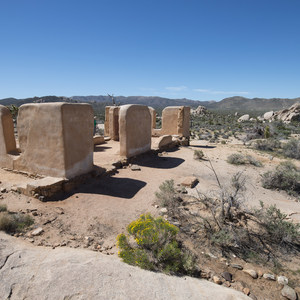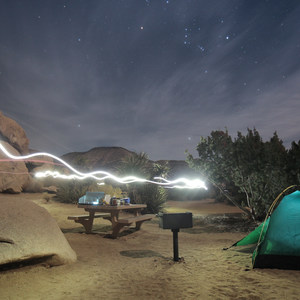Quail Mountain Loop is a 16.4-mile loop trail in Joshua Tree National Park that leads to the top of the park's highest peak. If you're looking for a challenging adventure in a secluded area of the park, this lightly traveled backcountry route is a great choice. The trail is rugged and steep with some sections that require cross-country travel. You will walk through a desert landscape, through sandy terrain, and up steep boulders along the way. This is a strenuous hike that is recommended for experienced hikers and backpackers who are comfortable navigating off-trail sections. This route can be completed as a long day hike or an overnight backpacking trip (see information below regarding permits).
With a height of 5,816 feet, Quail Mountain is not only Joshua Tree National Park's highest point, but also the highest point within the Little San Bernardino Mountains.
Beginning at Juniper Flats Trailhead, the route follows the California Riding and Hiking Trail (CRHT) for 4.5 miles. From Juniper Flats, follow Juniper Flats Road (dirt road) north for half a mile until it ends. The cross country begins at the end of the dirt road. Travel across the desert in the direction of Quail Mountain's southeast end.
From the mountain's base, you can choose your own adventure. To reach the summit, hikers can either ascend the canyon directly or traverse across one of the ridges. Several routes can lead to the summit; however, there are no trails leading there.
As you reach the summit, take a moment to enjoy the 360 degree views. The Mojave Desert lies to the north. To the south is the Salton Sea. To the southwest are the San Jacinto Mountains. The San Bernardino Mountains lie in the west. And, towards the east is Pinto Mountain.
On some maps, you might be able to see a faint x-country trail that descends the northwest slope from the top, eventually connecting with the CRHT. Follow the CRHT southeast until it intersects Juniper Flats Road. For variety, this route returns to the start along Juniper Flats Road, but retracing your steps can also be done via the CRHT.
SEASONS
This hike is best in the fall and spring (October - May), when temperatures are more mild. Winter is manageable but it can get cold and windy and summer is extremely hot with little exposure and no water.
WATER
There is no shade or water along this route, all water must be brought with you and carried throughout the duration.
PARK FEES
Joshua Tree National Park charges a fee to enter. For more information, please visit https://www.nps.gov/jotr/planyourvisit/fees.htm.
BACKCOUNTRY PERMIT AND CAMPING
A permit is required for backcountry camping in the park. Permits are easily accessible at a number of trailheads within the park and more information can be found at https://www.nps.gov/jotr/planyourvisit/backpacking.htm.
ADDITIONAL INFORMATION































Comments
Sign In and share them.